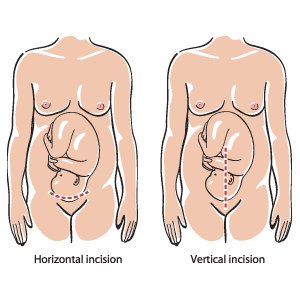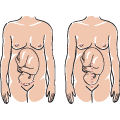Description of the procedure
A caesarean section is the surgical delivery of a baby. The baby is delivered through an opening made in the lower abdomen and uterus instead of through the vagina. Caesarean births take place in the hospital.
Usually, regional anesthesia is used, though in some cases general anesthesia may be used. Regional anesthesia is anesthesia that goes into the space around the spinal cord (e.g., epidural or spinal).
When should this procedure be performed?
A caesarean section delivery may be planned in advance, or your doctor may decide during labour that it is necessary. If you have had a previous caesarean section, your doctor may recommend this method for future deliveries due to an increased risk of complications, though vaginal birth is still possible.
It is important to discuss the pros and cons with your doctor before labour occurs.
Why is this procedure performed?
Caesarean sections are generally performed if vaginal delivery poses a risk to either the mother or baby. The risk may be due to:
- the baby's position in the uterus
- changes in the baby's heart rate, indicating a decreased oxygen supply
- the labour not progressing normally
- problems with the placenta or position of the umbilical cord
- certain health problems of the mother (e.g., active genital herpes) or baby
- a baby that is too big for vaginal delivery
- presence of more than one baby
- the mother having had a caesarean section in the past (and thus having an increased risk of complications with vaginal birth)
Some women choose to deliver via caesarean section for reasons other than medical ones.
Are there any risks and precautions?
Delivery via caesarean section poses risks to both the mother and baby.
Risks to the mother include:
- infection, bleeding, and reaction to the anesthetic (risks common to all surgeries)
- decreased bowel function and urinary tract infection in the days following surgery
- damage to nearby organs (such as the bladder)
- blood clots in the legs, lungs, or pelvic organs
- increased risk of uterine rupture with future vaginal births (rarely)
Babies born via caesarean section are more likely to experience rapid breathing during the first few days following birth. Though this condition usually resolves itself after 2 to 3 days, the baby may require additional oxygen until then. As well, there is also the risk that the baby can be accidentally scratched during surgery, though this complication is rare.
If you are concerned about any symptoms following this procedure, speak to your doctor. Take the time to be sure you understand all the risks of complications and side effects as well as any precautions your or your doctor can take to avoid them. Be sure your doctor understands all your concerns.
What happens during the procedure?
An intravenous (IV) will be inserted in your arm to provide fluid and medication. You will also be given oxygen until the baby is born. Then you will be given a regional anesthetic followed by a catheter to drain urine from the bladder.
Regional anesthesia is a medication that blocks the nerves to a part of the body - in this case, it is delivered into the space around the spinal cord. You are awake during the procedure. General anesthesia is used during an emergency when there is little time, or when you cannot have a regional anesthetic for some reason.
Your abdomen will be cleaned with antiseptic, after which your doctor will cut through the lower abdomen into the uterus and remove the baby (you may feel pressure and some tugging). You may also feel shaky, lightheaded, short of breath, or nauseous. After the baby is removed, your doctor will suction fluids from the baby's nose and mouth and then cut the umbilical cord.
Finally, the doctor will remove the placenta. The doctor then closes the opening in the uterus with stitches that will dissolve over time. The abdomen will either be closed with stitches or staples.
The entire caesarean section procedure takes less than an hour. Generally, the baby is born during the first 5 to 10 minutes, and your doctor will spend the rest of the time removing the placenta and closing the incision.
If your partner is present for the procedure, they will be asked to sit near your head. Your abdomen will be covered up to your shoulders.
There are two types of openings made in the uterus: horizontal and vertical.
A horizontal opening across the lower end of the uterus, called a low transverse incision, is more common. Vertical openings are now reserved only for emergencies or special situations. A vertical opening is made if the baby needs to be delivered quickly.
Many women can have a vaginal birth in the future after a caesarean. The old adage "once a caesarean, always a caesarean" is no longer true. Talk to your doctor about the benefits and risks of having a vaginal delivery after a caesarean.
How should I prepare for this procedure?
Before having this procedure, discuss the advantages, disadvantages, long-term risks, and consequences associated with the procedure with your doctor. Be sure you fully understand what will happen and are comfortable with your doctor's answers to your questions.
If your caesarean section is planned, you may be told not to eat for 8 hours before the procedure. You may be able to continue to drink clear liquids until 2 hours before the procedure. If your doctor has recommended different times, follow the timing recommended by your doctor.
Your doctor may recommend that you have blood tests done before the procedure. Your doctor may also take a sample of fluid from your uterus (through a procedure called amniocentesis), which will be analyzed to make sure that your baby is ready for birth.
If the procedure becomes necessary during labour, you may not have time to prepare.
Tell your doctor or prescriber about all prescription, over-the-counter (non-prescription), and herbal medications that you are taking. Also tell them about any medication allergies and medical conditions that you may have.
Ask your doctor or pharmacist whether you need to stop taking any of your medications before the procedure.
What can I expect after the procedure?
Immediately following the procedure, you will be brought into the recovery room and observed while the anesthetic wears off. Afterwards you will be transferred to the maternity ward.
You will likely start to feel some pain in the hours following a caesarean. Your doctor may give you additional pain-relieving medication if necessary. Your catheter and IV will likely be removed within 12 to 24 hours after the caesarean section; you are encouraged to start walking around within 24 hours after the procedure. Most women are able to eat solid food within a day or two. You can breast-feed whenever you are ready to. You will likely spend 3 days in the hospital.
It takes about 4 to 6 weeks for your body to fully heal from a caesarean section. In the days and weeks following a caesarean section, it is important to avoid lifting anything heavier than your baby, or engaging in physical activities such as housework, in order to allow yourself to heal.
You should contact your doctor if you develop:
- signs of an infection (e.g., fever, foul-smelling vaginal discharge, pain or burning with urination, blood in the urine)
- heavy bleeding (e.g., soaking a maxi pad within one hour or passing large blood clots)
- signs of a blood clot (e.g., red or swollen areas in your legs that is painful)
Results
All material copyright MediResource Inc. 1996 – 2024. Terms and conditions of use. The contents herein are for informational purposes only. Always seek the advice of your physician or other qualified health provider with any questions you may have regarding a medical condition. Source: www.medbroadcast.com/procedure/getprocedure/Caesarean-Section


